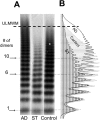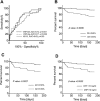Major Changes of von Willebrand Factor Multimer Distribution in Cirrhotic Patients with Stable Disease or Acute Decompensation
- PMID: 29972862
- PMCID: PMC6202934
- DOI: 10.1055/s-0038-1661393
Major Changes of von Willebrand Factor Multimer Distribution in Cirrhotic Patients with Stable Disease or Acute Decompensation
Abstract
Background: There is an unstable balance between pro- and anti-haemostatic processes in patients with cirrhosis. We hypothesized, that in patients with acute decompensation (AD) the major alterations of von Willebrand factor (VWF) could contribute to the pro-thrombotic situation as compared to patients with stable (ST) cirrhosis.
Patients and methods:
We analysed different parameters of VWF, including detailed multimer distribution by densitometry and platelet adhesion, together with
Results: VWF antigen, ristocetin co-factor as well as collagen-binding activities were elevated in both cirrhotic groups in a stepwise manner. There was a decrease in high and an increase in low molecular weight multimer ratios in the majority of ST cirrhosis. However, in 24 out of 54 AD patients, ultra-large VWF multimers (ultra-large molecular weight multimers [ULMWM]) were found. ADAMTS13 activity in ST and AD patients without ULMWM was similar to controls (median [interquartile range; IQR]%: 98 [67-132] and 91 [60-110] vs. 106 [88-117], respectively). The presence of ULMWM in AD patients was associated with low ADAMTS13 activity [33 (24-49)%] and high CRP level [23 (7.1-83.6) mg/L]. Adhesion of normal platelets showed a stepwise increase in the presence of cirrhotic plasmas, reaching the highest level in AD patients with ULMWM.
Conclusion: Characteristic changes of VWF parameters are seen in ST cirrhosis. In AD patients, highly increased VWF and reduced ADAMTS13 activity could be found, along with the presence of ULMWM, which are possible markers and contributors of the disease progression.
Georg Thieme Verlag KG Stuttgart · New York.
Conflict of interest statement
None.
Figures







Similar articles
-
An unbalance between von Willebrand factor and ADAMTS13 in acute liver failure: implications for hemostasis and clinical outcome.Hepatology. 2013 Aug;58(2):752-61. doi: 10.1002/hep.26372. Epub 2013 Jul 1. Hepatology. 2013. PMID: 23468040
-
The ADAMTS13-von Willebrand factor axis in COVID-19 patients.J Thromb Haemost. 2021 Feb;19(2):513-521. doi: 10.1111/jth.15191. Epub 2020 Dec 18. J Thromb Haemost. 2021. PMID: 33230904 Free PMC article.
-
Levels and activities of von Willebrand factor and metalloproteinase with thrombospondin type-1 motif, number 13 in inflammatory bowel diseases.World J Gastroenterol. 2017 Jul 14;23(26):4796-4805. doi: 10.3748/wjg.v23.i26.4796. World J Gastroenterol. 2017. PMID: 28765701 Free PMC article.
-
Interactions of von Willebrand factor and ADAMTS13 in von Willebrand disease and thrombotic thrombocytopenic purpura.Hamostaseologie. 2014;34(3):215-25. doi: 10.5482/HAMO-13-08-0045. Epub 2014 Jul 10. Hamostaseologie. 2014. PMID: 25010251 Review.
-
Control of von Willebrand factor multimer size and implications for disease.Blood Rev. 2002 Sep;16(3):185-92. doi: 10.1016/s0268-960x(02)00017-6. Blood Rev. 2002. PMID: 12163004 Review.
Cited by
-
Von Willebrand factor processing in patients with advanced chronic liver disease and its relation to portal hypertension and clinical outcome.Hepatol Int. 2023 Dec;17(6):1532-1544. doi: 10.1007/s12072-023-10577-y. Epub 2023 Aug 21. Hepatol Int. 2023. PMID: 37605068 Free PMC article.
-
Targeting von Willebrand factor in liver diseases: A novel therapeutic strategy?J Thromb Haemost. 2021 Jun;19(6):1390-1408. doi: 10.1111/jth.15312. Epub 2021 May 3. J Thromb Haemost. 2021. PMID: 33774926 Free PMC article. Review.
-
Assessment of hemostatic profile in patients with mild to advanced liver cirrhosis.World J Gastroenterol. 2020 May 7;26(17):2097-2110. doi: 10.3748/wjg.v26.i17.2097. World J Gastroenterol. 2020. PMID: 32536777 Free PMC article.
-
Plasma Level of von Willebrand Factor Propeptide at Diagnosis: A Marker of Subsequent Renal Dysfunction in Autoimmune Rheumatic Diseases.Clin Appl Thromb Hemost. 2020 Jan-Dec;26:1076029620938874. doi: 10.1177/1076029620938874. Clin Appl Thromb Hemost. 2020. PMID: 32705883 Free PMC article.
-
Primary Hemostasis in Chronic Liver Disease and Cirrhosis: What Did We Learn over the Past Decade?Int J Mol Sci. 2020 May 6;21(9):3294. doi: 10.3390/ijms21093294. Int J Mol Sci. 2020. PMID: 32384725 Free PMC article. Review.
References
-
- Tripodi A. Liver disease and hemostatic (dys)function. Semin Thromb Hemost. 2015;41(05):462–467. - PubMed
-
- Lisman T, Porte R J. Rebalanced hemostasis in patients with liver disease: evidence and clinical consequences. Blood. 2010;116(06):878–885. - PubMed
-
- Lisman T, Bongers T N, Adelmeijer J et al.Elevated levels of von Willebrand Factor in cirrhosis support platelet adhesion despite reduced functional capacity. Hepatology. 2006;44(01):53–61. - PubMed
-
- La Mura V, Reverter J C, Flores-Arroyo A et al.Von Willebrand factor levels predict clinical outcome in patients with cirrhosis and portal hypertension. Gut. 2011;60(08):1133–1138. - PubMed
MeSH terms
Substances
LinkOut - more resources
Full Text Sources
Other Literature Sources
Medical
Research Materials
Miscellaneous

